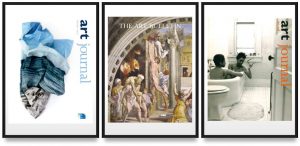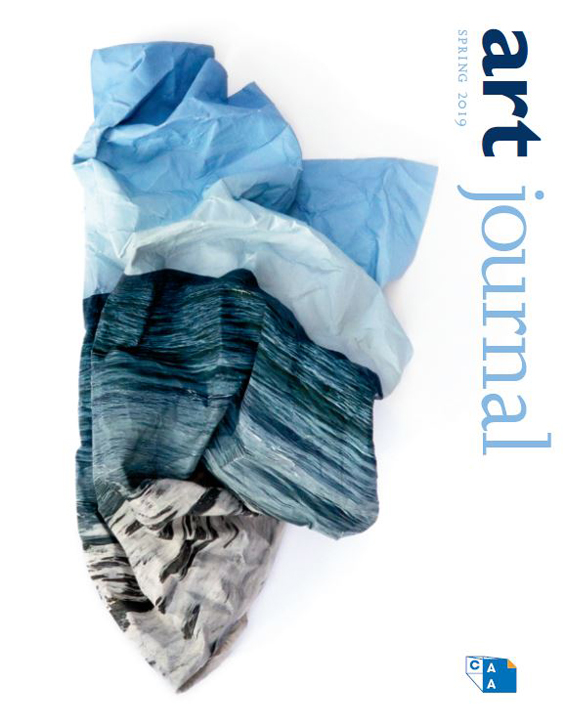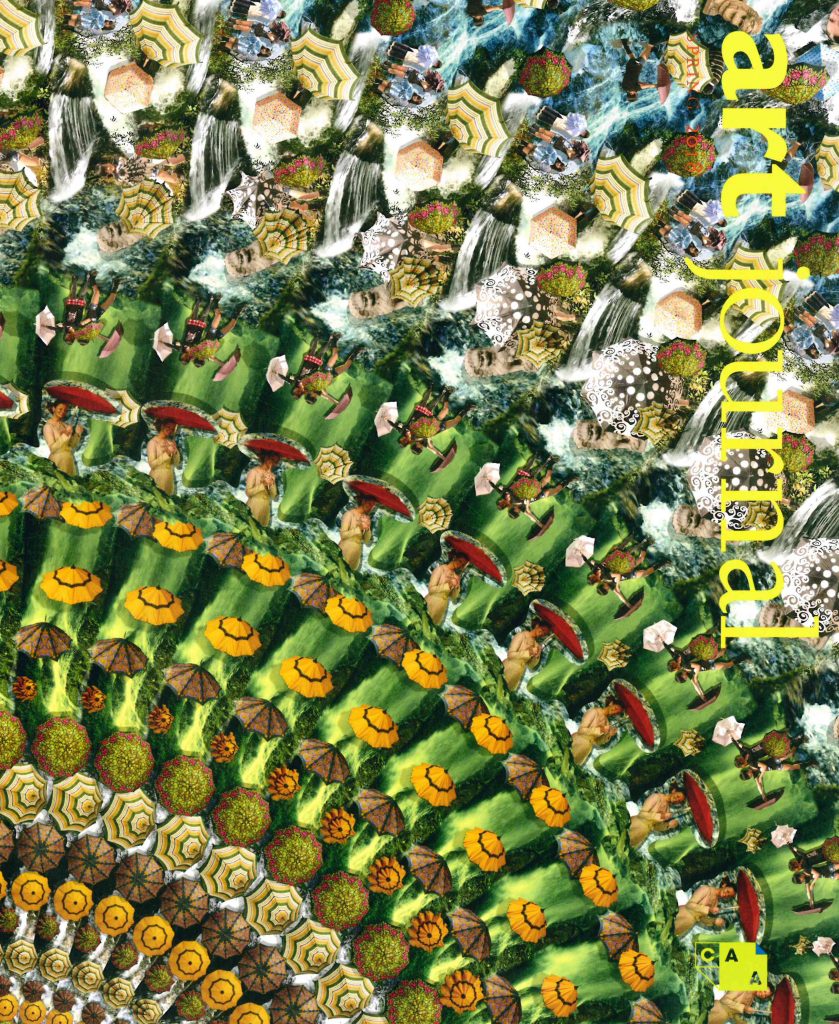CAA News Today
Marking Indigenous Peoples’ Day with Art Journal
posted by CAA — October 14, 2019
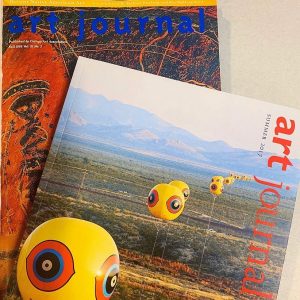
In celebration of Indigenous Peoples’ Day we have brought out from behind the paywall two issues of Art Journal in their entirety: our Summer 2017 issue on Indigenous Futures, (featuring Postcommodity’s Repellent Fence on the cover) and our Fall 1992 issue on Recent Native American Art. Articles from each will be open access until the end of October.
Celebrate Pride with CAA’s LGBTQ+ Article Collection
posted by CAA — June 13, 2019
Learn more about Art Journal and The Art Bulletin.
An Interview with Jordana Moore Saggese, Editor-in-Chief of Art Journal
posted by CAA — May 21, 2019

Photo by Sarah Deragon, Portraits to the People
Jordana Moore Saggese is an Associate Professor of American Art at the University of Maryland, College Park and the current Editor-in-Chief of Art Journal, CAA’s publication focused on twentieth- and twenty-first-century art history. Trained as an art historian, Saggese’s work focuses on modern and contemporary art with an emphasis on the expressions and theorizations of blackness. She was previously Associate Professor of Contemporary Art & Theory at California College of the Arts.
Joelle Te Paske, CAA Media and Content Manager, corresponded with her this month to learn about how she came to do the work she does, and her aspirations for the journal and the field beyond.
Joelle Te Paske: Thanks for taking the time for our interview, Jordana. So to begin, where are you from originally? What pathways led you to the work you’re doing now?
Jordana Moore Saggese: I am originally from Nashville, Tennessee. I attended Vanderbilt University, as a first-generation college student, for my undergraduate degree, and fell into an art history major at the very last moment. In fact, the summer before my senior year I suddenly realized that every opportunity I had to take an elective unit during my time at Vanderbilt I had chosen an art history class. The art history classes I took with my mentor Leonard Folgarait were truly inspiring. He encouraged his students (even those like me, who had very little knowledge of art history) to consider the work of artists as a response to the values and ideas of society, which in turn are determined by historical conditions. I can still remember his lecture on Dada, which was really the turning point for me. It was at that moment that I realized art was not something meant only for the elite; art could also be a form of rebellion. Although I had never been inside an art museum before my time as an undergraduate, Dr. Folgarait, and other faculty there, encouraged me and asked me to think deeply about the stakes of representation and introduced me to a range of objects across multiple continents and chronologies. With their encouragement, I decided to declare a major in art history and apply for graduate school my senior year.
This meant that I had to take the two-semester survey course as a senior, which fundamentally shifted the way I think about teaching those courses.
I can still remember my shock, sitting in a huge lecture hall, listening to someone drone on about a mostly white, male, heterosexist art history. I was wholly unprepared to memorize a seemingly endless stream of images. I finished the courses but this was not the art history that I was used to. That experience, of coming in almost backwards to the discipline, highlighted two main issues that still impact my teaching and research today.
First, how can we give students the very best introduction to the discipline—one that reflects the deep inquiry and the collaboration that was so intrinsic to my experience in the upper-division courses?
And second, whose art history are we teaching? That is, to what extent has a colonialist logic pervaded much of modern art history and what can I do—in my teaching and research—to undo that logic? I have been acutely aware of the ways in which art history has tended to exclude diverse perspectives and histories and much of my own work involves complicating those dominant narratives.
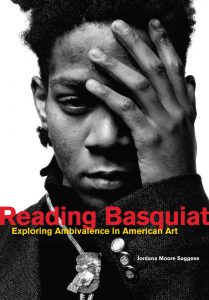
Saggese’s first book, Reading Basquiat: Exploring Ambivalence in American Art, was published by UC Press in 2014.
JTP: I love these questions as a fundamental starting point—not supplement—to the question of teaching art history. You were previously on the faculty at the California College of the Arts, and are now at University of Maryland, College Park. How has the transition been?
JMS: Teaching at an art school for the first ten years of my career was a wonderful experience in that it gave me direct and constant access to working artists. Thanks to my colleagues I was able to stay current in the field—a challenge for any historian of contemporary art—and my students constantly challenged me to make the history of art come into real time and space. CCA was also a site of experimentation, where students and faculty were willing to challenge one another, to wrestle openly with difficulty, and to fail. I have tried to bring those values to my teaching at Maryland as well. I have found the students and faculty at College Park to be deeply invested in their individual fields of interest but also in the discipline as a whole. There has also been tremendous support for my research practice, which has been a great benefit to making this transition.
JTP: As a Basquiat scholar, what is something you wish more people know about the artist?
JMS: I wish that more people considered the extent to which Basquiat’s celebrity status has threatened to eclipse his critical significance. My main project has been, and continues to be, writing this artist into the history of American art. I would also add that working on Basquiat presents extreme challenges for a researcher. There is no public archive of his work and approximately 85-90% of the paintings and drawings are in private collections (and I might mention, constantly being sold). This means that in order to see the works, one must shake a lot of hands, charm a lot of people, and knock on lots of doors. Working on Basquiat requires a thick skin, as I am often embroiled in territorial battles or even ignored. I also spend a lot of money traveling to see exhibitions so that I might glimpse the works in person. So, it’s not your typical research project!
JTP: I can only imagine the challenges that presents in pushing research forward—it’s far from a straightforward dive into the archives. What are you working on currently?
JMS: My second book, The Basquiat Reader: A Critical Anthology will be published by the University of California Press in 2020. The Basquiat Reader is a comprehensive sourcebook on Basquiat for both general audiences and advanced readers. Through a combination of interviews with the artist, criticism from the artist’s lifetime and immediately after, previously unpublished research by me, and a selection of the most important critical essays on the artist’s work, The Basquiat Reader provides a full picture of the artist’s views on art and culture, his working process, as well as the critical significance of his work both then and now. It is my hope that by giving more people access to the primary sources, we will see more scholarship on this artist.
My new book project considers representations of black male athletes as a point of entry to thinking about how black men have historically been presented to (and positioned by) the white mainstream public as a fear/fantasy. More specifically, I examine the ways in which black masculinity is constructed in the visual realm, and how the black athletic body can shape the moral, physical, and social position of African American men more broadly. Over five chapters I analyze key moments in the history of the sport, prominent black athletes and their representation in the American popular press and visual art.
JTP: That is such important work, especially as those constructions persist and accelerate in contemporary visual culture. What are your hopes for Art Journal during your tenure?
JMS: During my tenure I would like to continue to build on the global reach of the publication—in terms of both content and readership. I mean global here as something more than a keyword to signal “diversity.” I use global to signal an interconnected conversation between Europe, Asia, Africa, Latin America, South America, the Pacific—rather than a series of isolated references to an “other.” I want to think of how the perspective of modern and contemporary art from Mumbai or even Beijing connects to as well as lives separate from the touch-points of America and Europe. This is something that I began to explore in my edited forum, “Diversity and Difference,” published in Art Journal in 2016—that is, how can we think beyond the paradigm of margins and center?
I am also hoping to increase a direct engagement of artist members via the introduction of new features, such as “Object Lessons,” which will first appear in Fall 2019. This is an opportunity for artists to consider a specific object of visual culture that has directly impacted or influenced their own practice. I am also increasing the diversity of artists that we publish in Art Journal. For example, every artist project for issues published in 2019 was developed by a woman of color.
Finally, I want to highlight the role of the journal as a forum for professional conversations. Readers can expect to see short essays on fair use, censorship, and the white supremacist logic of art history—topics that typically are buried in whispers. I see Art Journal as a place where these difficult conversations and issues come to light. Many readers of Art Journal are also teachers, and I hope to bring more focus to issues of pedagogy over the coming years of my tenure as Editor-in-Chief.
JTP: It’s exciting to see the direction you are bringing to it. What are some of your other arts-related recommendations at the moment?
JMS: I have really enjoyed seeing the conversation around #POCarthistory (started by Ananda Cohen-Aponte [who recently took over CAA’s Instagram]) develop on Twitter over the last months. As someone interested in our current moment I am constantly reading Hyperallergic and I have found the resources on the website of the Association for Critical Race Art History very important to my own pedagogical development. I am currently reading The Painter’s Touch by Ewa Lajer-Burcharth.
JTP: Do you have a favorite exhibition you’ve seen recently?
JMS: This year I really enjoyed the shows by Jack Whitten (Met Breuer) and Nari Ward (New Museum), but I am still reeling from the show of new paintings by Lynette Yiadom-Boakye (Under-Song for a Cipher), which I saw at the New Museum two years ago. That show left me speechless.
The Spring 2019 issue of Art Journal is now online.
Not a CAA member? Join today and begin exploring immediately.
Explore the Latest Issue of Art Journal
posted by CAA — August 09, 2018
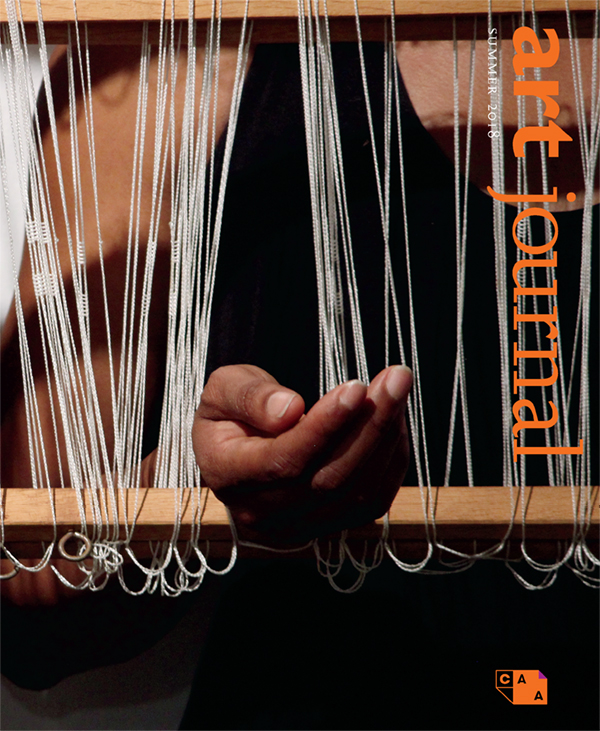
Print copies of the Summer 2018 issue of Art Journal will arrive in mailboxes this week.
In This Issue
Rebecca M. Brown
Ghostly Presences
Artist’s Project
Indira Allegra
The Pull of Unseen Forces: Stages of BODYWARP
Features
Jenni Lauwrens
More than Meets the Eye: Embodied Engagement with After the Last Supper
Russell Stephens
Extinct?—An Art Intervention by Ravi Agarwal in Delhi
Iliana Cepero
Reading Tatlin’s Tower in Socialist Cuba
Krista Thompson ●
“I WAS HERE BUT I DISAPEAR”: Ivanhoe “Rhygin” Martin and Photographic Disappearance in Jamaica
Reviews
Bridget R. Cooks on Kellie Jones, South of Pico: African American Artists in Los Angeles in the 1960s and 1970s; Dominic Johnson on Karen Gonzalez Rice, Long Suffering: American Endurance Art as Prophetic Witness; Dina A. Ramadan on Sam Bardaouil, Surrealism in Egypt: Modernism and the Art and Liberty Group; Ella Maria Diaz on Karen Mary Davalos, Chicana/o Remix: Art and Errata since the Sixties
Zachary Kaiser
Advanced Analytics for a Better University
Not a member? Click here to join CAA and explore the issue in full.
The Avant-Garde and the Global South, Artworks in Motion, and More in Art Journal
posted by CAA — May 15, 2018
“Proposition Avant-Garde: A View from the South,” by Geeta Kapur, the distinguished art critic, challenges readers of Art Journal to reconsider, reclaim, and rethink the idea of the avant-garde. The text by the Delhi–based Kapur appears for the first time in the Spring 2018 issue of the journal, along with responses from the scholars Saloni Mathur and Rachel Weiss.
Also featured in the recently published issue are two projects by artists whose works provide illusions of motion. For The Virtual Immigrant, Annu Palakunnathu Matthew created a flip-motion lenticular card, inserted in each copy of the journal, which reveals two interlaced portraits of a young call center worker in India, one image in the casual Western address she wears at work, where she speaks in an acquired American accent, the other in the traditional Indian clothing she wears on more formal occasions. Matthew’s project features multiple portraits of three other call center workers; by calling a toll-free number (844-984-7882) on the back of the card, readers can hear short recordings in which the workers speak about the two cultures they inhabit in the course of their lives.
In his project Material Motion, Eric Dyer exhibits works from the last dozen years based on the zoetrope, a form of animation devised in the nineteenth century. Stills featured on the cover and interior pages of the journal show the evolution of the idea in the artist’s hands, first in spinning sculptures that reveal dozens of tiny animated details—cyclists zooming through an urban landscape; umbrellas furling, unfurling, and passing through rows of people and other umbrellas. Dyer further extended the zoetrope principle in numerous other animated pieces, including two DIY pieces that Art Journal readers can complete with a record turntable and a smartphone app.
The issue features three long-form scholarly essays: the curator Luigia Lonardelli on the unfolding of the 1973 Contemporanea, a massive multidisciplinary exhibition staged in an underground parking lot in Rome; Nika Elder on the repeated appearance of a seemingly simple shift dress in the 1980s–90s photographs of Lorna Simpson, a garment closely examined here for the first time; and Steven Jacobs on a 1960 film by Luc de Heusch in which René Magritte extended his artistic project through cinematic means, gnomically restaging some of his best-known paintings in his home.
The Reviews section opens with Joe Madura’s assessment of the exhibition and catalogue for Art, AIDS, America, with a special focus on the final iteration of the traveling show in Chicago. The section continues with reviews of Amy Bryzgel’s Performance Art in Eastern Europe (reviewed by Adair Rounthwaite), Jenni Sorkin’s Live Form: Women, Ceramics, and Community (by Glenn Adamson), and Jane McFadden’s Walter De Maria: Meaningless Work (by Amanda Boetzkes).
CAA sends print copies of Art Journal to all institutional members and to those individuals who choose to receive the journal as a benefit of membership. The digital version at Taylor & Francis Online is currently available to all CAA individual members regardless of their print subscription choice.
Want to see more? Join CAA today and explore the Spring issue in full.
New Curatorial Approaches in Art Journal
posted by CAA — February 06, 2018
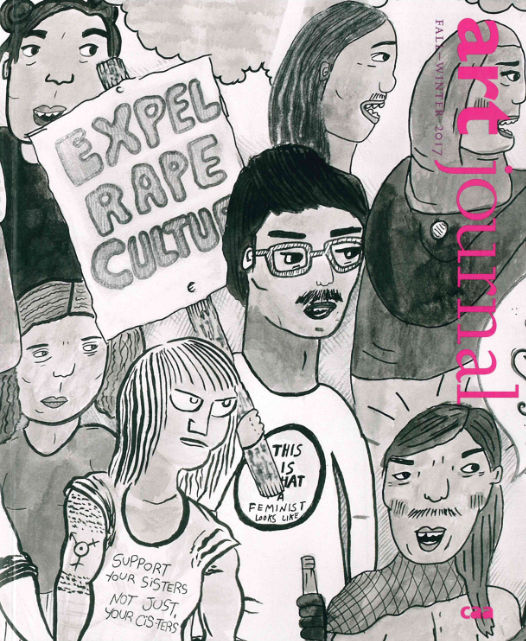
“Curating New Openings: Rethinking Diversity in the Gallery” is the centerpiece of the recently published Fall–Winter issue of Art Journal. The forum, organized by Amanda Cachia, highlights the experimental ideologies and methodologies of curators who root their projects in diversity in ways beyond conventional considerations of difference and access. It features texts by the curators Eliza Chandler, Anne Ellegood, Catherine Flood, Massimiliano Gioni, Naima J. Keith, Rhonda L. Meier, Helena Reckitt, Sara Reisman, Franklin Sirmans, and Cachia herself. The art historian Jonathan D. Katz contributes a polemical text on his dislike of the term “diversity.” The forum also showcases artworks by Firelai Báez, Fayen d’Evie, the collective Gender/Power, Christine Sun Kim, Nadia Myre, Alison O’Daniel, and Matt Smith. And for the first time in Art Journal, captions in the forum include image descriptions.
The afrotrope, the idea of recurrent forms in African and African diasporic visual cultures, is also a recurrent thread in Art Journal. In this issue, the originators of the concept, Huey Copeland and Krista Thompson, reintroduce the theme in a short “user’s guide.” An essay by Allison K. Young then traces the path of afrotrope images from documentary photographs of the 1976 Soweto uprising through artworks created outside South Africa in the following years, particularly in the screenprints of the UK-based artist Gavin Jantjes.
An essay by Tim Stott, a Dublin-based historian, explores the geometries, patterns, and diagrams of paintings, digital prints, and sculpture by Gabriel Orozco, in particular the knight’s move the artist has borrowed from chess.
#silence=violence, an artists’ project by Deirdre Logue and Allyson Mitchell with Heidi Cho and Morgan Sea, unfolds in the issue—quite literally, in a series of unfurling, densely illustrated pages. Responding to an invitation from the Doris McCarthy Art Gallery of the University of Toronto, the artists created the triptych of large-scale drawings, which then became the basis for murals at the university. Dozens of activist figures stream across the panels, addressing sexual violence and harassment on campuses with passion, resolution, and wit—even Siri puts in a cameo appearance.
The Reviews section opens with a critical bibliography on the theme of “possibility aesthetics” in the Anthropocene epoch by the artist Andrew Yang, who ponders eight publications—a graphic novel, a performative lecture, a manifesto, and more—as “opportunities for perceiving the complexity of planet-size facts.” The section continues with reviews of the exhibition and catalogue for A Feast of Astonishments: Charlotte Moorman and the Avant-Garde, 1960s–1980s (by Nicole L. Woods), the exhibition and catalogue for Lynn Hershman Leeson: Civic Radar (by Robert Slifkin), and the exhibition catalogue The Passion according to Carol Rama (by Jennifer Griffiths).
CAA sends print copies of Art Journal to all institutional members and to those individuals who choose to receive the journal as a benefit of membership. The digital version at Taylor & Francis Online is currently available to all CAA individual members regardless of their print subscription choice.
Call for Nominations for CAA Publications
posted by CAA — February 06, 2018
Self-nominations and nominations are now open for several positions with CAA publications. Click the links below to learn more.
THE ART BULLETIN
Call for Editor-in-Chief, The Art Bulletin
The Art Bulletin Editorial Board invites nominations and self-nominations for the position of editor-in-chief for a three-year term: July 1, 2019–June 30, 2022, with service as incoming editor designate, July 1, 2018–June 30, 2019, and as past editor, July 1, 2022–June 30, 2023. The candidate should have published substantially in the field and may be an academic, museum-based, or independent scholar; institutional affiliation is not required. The Art Bulletin features leading scholarship in the English language in all aspects of art history as practiced in the academy, museums, and other institutions. From its founding in 1913, the quarterly journal has published, through rigorous peer review, scholarly articles and critical reviews of the highest quality in all areas and periods of the history of art. Click here to learn more.
Deadline: Monday, April 2, 2018; finalists will be interviewed on Friday, May 4.
ART JOURNAL
Art Journal Seeks Reviews Editor – deadline extended!
The Art Journal Editorial Board invites nominations and self-nominations for the position of reviews editor for a three-year term: July 1, 2019–June 30, 2022 (with service as incoming reviews editor designate, July 1, 2018–June 30, 2019). The candidate may be an artist, art historian, art critic, art educator, curator, or other art professional; institutional affiliation is not required. Art Journal, published quarterly by CAA, is devoted to twentieth- and twenty-first-century art and visual culture. Click here to learn more.
Deadline extended! New deadline is: Tuesday, April 17, 2018; finalists will be interviewed on Thursday, May 3.
Art Journal Editorial Board Seeks New Members
CAA invites nominations and self-nominations for two individuals to serve on the Art Journal Editorial Board for a four-year term: July 1, 2018–June 30, 2022. Candidates may be artists, art historians, art critics, art educators, curators, or other art professionals; institutional affiliation is not required. Art Journal, published quarterly by CAA, is devoted to twentieth- and twenty-first-century art and visual culture. Click here to learn more.
Deadline: Monday, April 16, 2018.
CAA.REVIEWS
caa.reviews Editorial Board Seeks Candidates
CAA invites nominations and self-nominations for two individuals to serve on the caa.reviews Editorial Board for four-year terms, July 1, 2018–June 30, 2022. Candidates may be artists, art historians, art critics, art educators, curators, or other art professionals with stature in the field and experience writing or editing books and/or exhibition reviews; institutional affiliation is not required. The journal also seeks a librarian to serve in an ex officio capacity to advise the editorial board on technical and distribution issues. Click here to learn more.
Deadline: Monday, April 16, 2018.
caa.reviews Seeks TEN Field Editors – deadline extended!
CAA invites nominations and self-nominations for TEN individuals to join the caa.reviews Council of Field Editors for a three-year term, July 1, 2018–June 30, 2021. An online journal, caa.reviews is devoted to the peer review of new books, museum exhibitions, and projects relevant to art history, visual studies, and the arts. Click here to learn more.
Deadline extended! New deadline is: Tuesday, May 1, 2018.
Indigenous Futures in Art Journal
posted by CAA — October 23, 2017
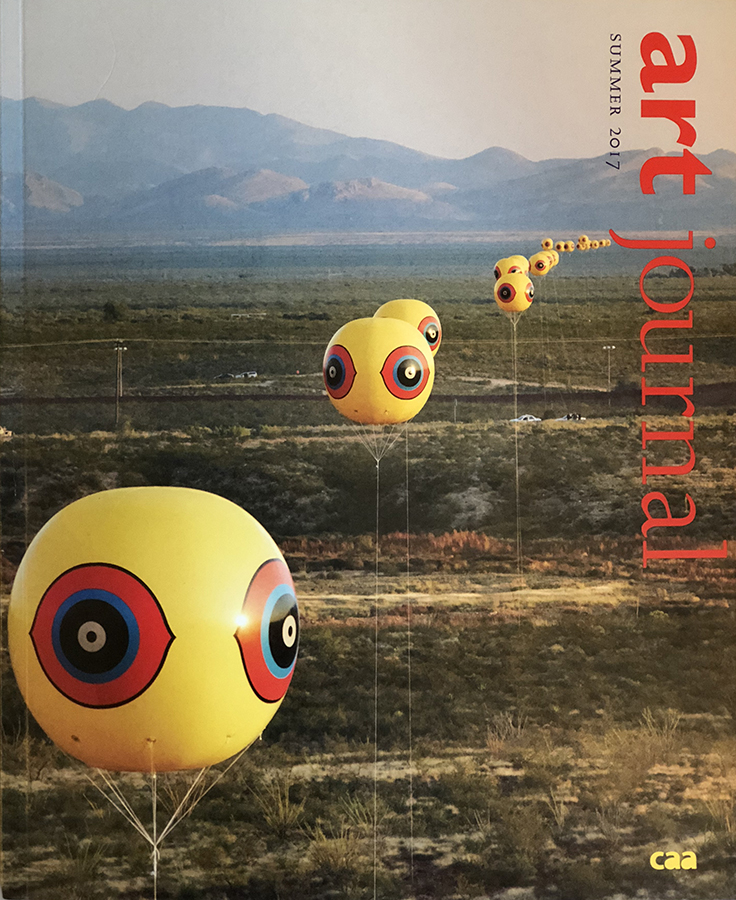
Postcommodity, Repellent Fence, 2015, installation view (artwork © Postcommodity; photograph by Michael Lundgren provided by Postcommodity)
Recent years have seen a boom in the creation of new art by Indigenous artists across North America—and a concomitant surge in scholarship about this art. The recently published issue of Art Journal is devoted to both the art and the research. In addressing the theme “Indigenous Futures,” editor-in-chief Rebecca M. Brown turned to the scholars Kate Morris and Bill Anthes as guest editors.
Works by dozens of Indigenous artists are featured in the issue, among them Kay WalkingStick, Kent Monkman, Shan Goshorn, Rebecca Belmore, Cheryl L’Hirondelle, Will Wilson, and Edgar Heap of Birds. The artist collective Postcommodity created a project for the issue that includes the covers. Two artists wrote substantial texts: Jolene Rickard explores the theme of sovereignty in Indigenous art, while Marie Watt enjoys a frank chat with Joseph Beuys’s Coyote—who is amazingly au courant about today’s art.
In addition to Morris and Anthes, the scholars Jessica L. Horton, Dylan Robinson, and Sherry Farrell Racette provide insights into bodies of work by specific artists. A strong curatorial thread runs through the issue as well, with essays by Candice Hopkins and Heather Igloliorte; a magisterial essay by the curators Kathleen Ash-Milby and Ruth B. Phillips traces the history of critical exhibitions in North American museums and galleries since 1992, the year of the controversial “celebration” of the Columbus quincentennial.
The Reviews section of the issue features a 2015 book by W. J. T. Mitchell (reviewed by Caroline A. Jones), a substantial anthology on the postwar avant-garde in Scandinavia (by Karen Kurczynski), the exhibition and catalogue of Hélio Oiticica: To Organize Delirium (by Camila Maroja), a multiauthor and -artist volume on the Indian city of Chandigarh (by Tracy Bonfitto), and the exhibition and catalogue of Leap Before You Look: Black Mountain College 1933–1957 (by Erica DiBenedetto).
CAA sends print copies of Art Journal to all institutional members and to those individuals who choose to receive the journal as a benefit of membership. The digital version at Taylor & Francis Online is currently available to all CAA individual members regardless of their print subscription choice.
Artists’ Legacies Unpacked in Art Journal
posted by CAA — July 05, 2017
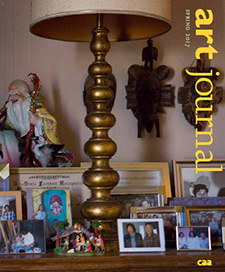 “What to do with all the stuff?” This is one of many questions posed—and provisionally answered—in the most recent issue of Art Journal, in an extensive multiauthor forum that delves into the complex matter of artists’ estates. “The Politics of Legacy,” guest-edited for the journal by Rachel Middleman and Anne Monahan, comprises contributions by no fewer than twenty-one artists and scholars. The texts include interviews (with, for example, Flavin and Rainer Judd, Mira Friedlaender, and Jane Kallir of Grandma Moses Properties, Inc.) and position papers (by Caroline A. Jones, Michael Corris, and Nancy J. Troy, among others). Central to the forum are three commissioned artists’ projects by Danh Vo (on the estate of Martin Wong), Mimi Gross (the estate of her father Chaim Gross, as well as her own legacy as an artist), and Jill Magid (the contested estate of the Mexican architect Luis Barragán).
“What to do with all the stuff?” This is one of many questions posed—and provisionally answered—in the most recent issue of Art Journal, in an extensive multiauthor forum that delves into the complex matter of artists’ estates. “The Politics of Legacy,” guest-edited for the journal by Rachel Middleman and Anne Monahan, comprises contributions by no fewer than twenty-one artists and scholars. The texts include interviews (with, for example, Flavin and Rainer Judd, Mira Friedlaender, and Jane Kallir of Grandma Moses Properties, Inc.) and position papers (by Caroline A. Jones, Michael Corris, and Nancy J. Troy, among others). Central to the forum are three commissioned artists’ projects by Danh Vo (on the estate of Martin Wong), Mimi Gross (the estate of her father Chaim Gross, as well as her own legacy as an artist), and Jill Magid (the contested estate of the Mexican architect Luis Barragán).
Elsewhere in the issue, editor-in-chief Rebecca Brown has selected three essays that deal with upheaval. Nazar Kozak details the interventions by Ukrainian artists during the 2013–14 uprising in Kyiv that brought down the nation’s government—artworks that at times literally became part of the armed barricade in the city’s central square. Sherry Buckberrough conjures the early twentieth-century context in which the Robert Delaunay created singular works with themes of androgyny, gender, and political violence. Sophie Landres explores sexual, corporeal, and musical interventions of the groundbreaking performances of Charlotte Moorman in late-1960s, as the new ideas of feminism reached the larger culture.
The issue marks the debut of reviews editor Kirsten Swenson, whose commissions explore books on Carolee Schneemann, on art in postwar South America, and on the trajectory of the choreographer Simone Forti. “The Prehistory of Exhibition History,” a critical bibliography by grupa o.k. (Julian Myers and Joanna Szupinska), completes the section.
CAA sends print copies of Art Journal to all institutional members and to those individuals who choose to receive the journal as a benefit of membership. The digital version at Taylor & Francis Online is currently available to all CAA individual members regardless of their print subscription choice.
Rebecca Uchill is the New Web Editor for Art Journal Open
posted by CAA — June 01, 2017
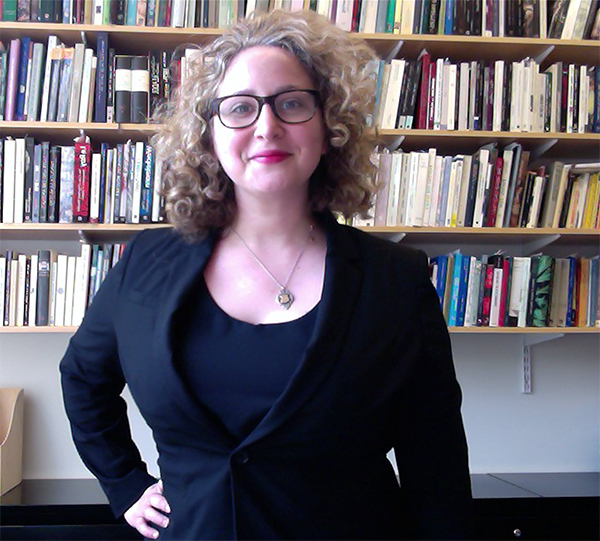
Rebecca Uchill
CAA’s president, Suzanne Preston Blier, has appointed Rebecca Uchill as the new web editor for Art Journal Open, endorsing the recommendation of the editorial board of Art Journal. Uchill, who currently is a Mellon Postdoctoral Fellow with the Center for Art, Science, and Technology at the Massachusetts Institute of Technology, joins the College of Visual and Performing Arts at UMass Dartmouth in September as a full-time lecturer. Uchill’s three-year term for Art Journal Open commences on July 1, 2017; she succeeds inaugural web editor Gloria Sutton, assistant professor of contemporary art history and new media at Northeastern University. During her term, Uchill will be responsible for commissioning and vetting content for the website, including artist projects and essays. She will serve on the Art Journal editorial board.
Uchill is the coeditor (with Caroline A. Jones and David Mather) of Experience: Culture, Cognition, and the Common Sense (MIT Press, 2016), as well as curator of the artist entries for the volume. She organizes interdisciplinary events and programs, including the recent “Being Material” symposium at MIT and a series of curatorial experiments with the collaborative Experience Economies. Uchill has published in journals such as Future Anterior, Museum and Curatorial Studies Review, Visual Resources: An International Journal of Documentation, and Journal of Curatorial Studies. She has curated exhibitions at Harvard University’s Carpenter Center for the Visual Arts, the Indianapolis Museum of Art, and Mass MoCA. Uchill earned her PhD in history, theory, and criticism of art at MIT in 2015.
CAA welcomes Rebecca Uchill to Art Journal Open.
Art Journal Open welcomes proposals for artists’ projects, critical writing, and other contributions, on a rolling basis. Please see the submission guidelines here. Submissions are accepted via e-mail to art.journal.open@collegeart.org.



